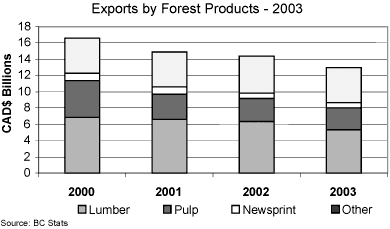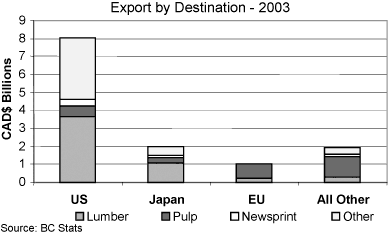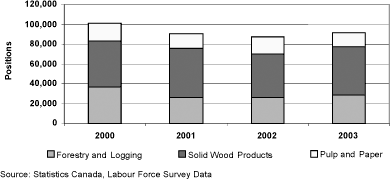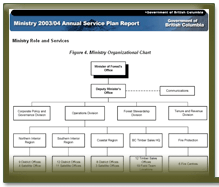 |
|
Ministry Role and ServicesMinistry OverviewSince its establishment in 1912 as the Forests Branch, the Ministry of Forests (also known as the Forest Service or MOF) has continued to protect the public's interest and provide leadership in the protection, management and use of the province's forest and rangelands. The Forest Service is the main agency responsible for the stewardship of 47 million hectares of provincial forestland. In addition, the ministry provides fire protection services for 84 million hectares. Managing these provincial forests presents a unique and complex set of challenges. More than 90 per cent of British Columbia's forestlands are publicly owned, which means that the provincial government, on behalf of the public, plays a much more prominent role in the forest sector than its counterparts in other forestry jurisdictions. The ministry pursues its goals for sustainable forest resources and benefits in a consultative manner with the public, industry, and other Crown agencies, while recognizing the unique interests of aboriginal people. In this way, the ministry works to earn the public's trust as our staff make the day-to-day decisions which ensure that all British Columbians can look forward to healthy forests and a strong forest economy now and in the future. The key legislation for which the Ministry of Forests is responsible is summarized in Appendix 1. Ministry Vision, Mission and ValuesVisionHealthy Productive Forests This vision reflects the ministry's mandate to ensure that the health and productivity of the province's forest and range resources are maintained now and in the future. Healthy forests include a diversity of ecosystems that support a full range of forest products, businesses and other opportunities. MissionProtect and manage our public forests for the sustained benefit of all British Columbians. This mission is reflected in the Forest Service's motto "Stewards of Our Forests". As stewards of British Columbia's forest and rangelands, the Forest Service undertakes the key responsibilities of: protecting and managing the province's forest and range resources; providing the basis for a globally competitive forest industry with high environmental standards; and maximizing net revenues to the Crown. ValuesThe Forest Service protects the public's interest in its forest and rangelands through a commitment to the values of respect, service excellence, accountability, openness and adaptiveness, and a can-do attitude. The ministry is guided by the ethics of sustainable use, stewardship, and public service.
Ministry Operating ContextIntroductionRecent policy changes and global forest issues continue to change the landscape of the BC forest sector. In 2003/2004, the ministry began the challenge of implementing the policy changes associated with the Forest Revitalization Plan and Forest and Range Practices Act. The ministry also continued to address the softwood lumber dispute, expand dialogue with First Nation groups, and work on forest management and health issues. From a global perspective, changing weather patterns and their impact on sustainable forest management continued to affect the forest sector. Similarly, consolidations and mergers, global excess wood supply and new entrants into traditional markets were forces shaping the BC forest sector's global performance. Internal ChallengesWith the ongoing implementation of the Forest and Range Practices Act, the ministry continued to adjust and fine-tune the legislative framework to ensure an efficiently functioning forest management system. Over the course of a year, 4,000 government and industry personnel underwent training on the new regulations and their application. With continued dry weather, wildfires were a threat to British Columbia communities, particularly in the Interior. The government undertook a review of its wildfire policies and procedures after the catastrophic events of 2003. The Filmon Firestorm 2003 Provincial Review discusses and recommends how the government can be better prepared to deal with future wildfires. The government began the process of implementing all 42 of the review's recommendations. For more information on these recommendations, please see the report at www.2003firestorm.gov.bc.ca/firestormreport/FirestormReport.pdf. A key component of the Forest Revitalization Plan was the continued commitment to increasing First Nation involvement in forestry through tenure and revenue sharing opportunities. Since September 2002, the government has signed agreements with 47 First Nations, which involve $53 million in revenue sharing and more than 9.3 million cubic meters in timber. The mountain pine beetle epidemic continued to be a priority issue for the ministry from both a forest health and an economic standpoint. British Columbia's mountain pine beetle epidemic has been described as the worst insect infestation ever to occur in a North American forest. The total area attacked by the mountain pine beetle now measures about 4.1 million hectares and the area has more than doubled since 2002. Finding market opportunities for the beetle-damaged wood remained a challenge for the sector. Forestry Innovation Investment Ltd. through funding under the Forest Investment Product Development Program worked with the Chinese Academy of Forestry to research possible uses for beetle-wood in China. The government also looked at encouraging other innovative uses for beetle-wood and an expression of interest process is underway. The three-year workforce adjustment plan concluded in 2003/04. During this year the ministry was reduced by 61 employees for a total three-year reduction of 893 employees. As a result of Government-wide exit programs, only 215 final layoff notices were issued. Of those, 94 employees were placed in vacancies elsewhere in government. External ChallengesSoftwood Lumber On May 22, 2002, the US imposed countervailing and anti-dumping duties on Canadian softwood lumber amounting to 27 per cent. Canadian federal and provincial governments and industry have been working to eliminate these duties, both through legal challenges under international trade rules, and through attempts to negotiate a long-term solution to the dispute. Some 2003/04 highlights with respect to this major issue included the following:
The Global Forest Industry Changes continued within the forest industry. There were mergers and takeovers within the global industry, which have resulted in a consolidation of production as multinational companies continue to pursue lower unit costs. British Columbia also saw its share of company changes in 2003/04; for example, Spring 2004 announcements of the Slocan-Canfor and Riverside-Lignum mergers. In addition, China and Russia are playing an increasingly important role in the global forest industry. China is rapidly expanding its wood processing capacity to meet its increasing domestic demand. Also, producers from Northern Europe have expanded investment in the Russia wood products industry. EconomicsGlobal Context The Japanese economy appears to be improving, but the value of British Columbia forest product exports to Japan did not increase in 2003. World prices for lumber, plywood and pulp increased substantially in 2003/04, but the Canada/US exchange rate appreciation in 2003 dampened some of this increase for Canadian producers. European exports to the US lumber market, while still quite small, have increased significantly since the introduction of the duties on Canadian products. Prices The BC forest industry's reliance on the export of their products into global markets makes commodity prices an important determinant of the sector's performance and health (see Table 1). Table 1. Commodity Prices
Exports British Columbia's forest-based industries produced an array of wood products during 2003, but were dominated by the production of lumber and pulp and paper, which are commodities sold in the world market (see Figure 1). The ministry's market-based policy reform is focused on supporting a globally competitive forest industry while ensuring that the public receives fair value for its resource. Overall, forest product exports from British Columbia have been declining since 2000. Based on preliminary data, total BC forest product exports in 2003 were $12.9 billion, down 29 per cent from 2002. A large portion of the decline is attributable to a reduction of softwood lumber exports. Softwood lumber typically accounts for over 40 per cent of total forest product exports (see Table 2). Table 2. Total Wood and Softwood Lumber Exports
The primary market for BC products continues to be the United States, which imported 62 per cent of British Columbia's total provincial forest product exports in 2003. Japan was the second largest destination for BC forest products accounting for approximately 15 per cent of the total (see Figure 2). Figure 1. Export by Forest Products
Figure 2. Exports by Destination
Employment Employment statistics in the BC forest industry showed a five per cent improvement in 2003 employment levels compared to 2002. Total employment rose from 87,300 to 91,617 positions. Despite a 15 per cent decline in pulp and paper employment, solid wood products and forestry and logging employment improved by nearly 10 per cent (see Figure 3). Figure 3. British Columbia Forest Industry Employment
Ministry Structure and Core Business AreasThe Ministry of Forests has a decentralized structure (see Figure 4), with the majority of staff in field offices in close proximity to the forests they protect and manage and the clients and communities they serve. The field structure of the ministry consists of three forest region offices with 29 forest district offices and 18 satellite offices; 12 BC Timber Sales offices with 19 field team locations; and six fire centres. Staff in field services are involved in all seven core business areas. The Victoria headquarters staff are organized as follows: Corporate Policy and Governance division, Operations division (Field Services, BC Timber Sales, and Fire Protection), Forest Stewardship division, Tenure and Revenue division, and Communications. The Forest Stewardship Division includes staff in the Forest Practices Branch, Research Branch, Forest Analysis Branch and the Tree Improvement Branch, which manages the Tree Seed center and six seed orchard facilities. In the Tenure and Revenue Division are Economics and Trade, Revenue, Resource Tenures and Engineering, and Aboriginal Affairs Branches. The Operations division personnel in Victoria are Executive and support staff to the BC Timber Sales, Fire Protection, and Field Services staff, and the Compliance and Enforcement Branch. Corporate Policy and Governance Division provides overall co-ordination of policy development and support services to the entire ministry in the areas of financial services, human resources, information technology, and strategic policy and legislation development. Figure 4. Ministry Organizational Chart
The ministry has seven core business areas that represent groupings of the ministry's activities based on commonality of role and purpose. These business areas structure the objectives, strategies and performance measures of the ministry. Core Business Area Forest ProtectionForest Protection includes fire protection and forest health management. The ministry manages wildfires to protect natural resource inventories and investments in the forest landbase. Forest fire response is primarily focused on protecting lives and government forest assets, particularly timber. Without fire protection, some 500,000 hectares of productive forest would be lost annually costing the province billions of dollars in potential direct revenue. The ministry undertakes cost sharing for fire protection activities with the forest industry, utility companies and landowners. The province also relies on industry to help with protecting the health of forests under their management, especially pest infestations. The ministry continues to have a significant obligation to manage infestations in parks and protected areas, and to manage defoliator outbreaks that span multiple jurisdictions. Of key significance are bark beetles and gypsy moth infestations. Other defoliators, endemic pests and outbreaks of local significance are also managed. Core Business Area Stewardship of Forest ResourcesThe functions in this core business area are fundamental to ensuring sound environmental stewardship of forest and range resources to ensure that they are used in a sustainable way. This in turn supports global recognition of environmental stewardship for British Columbia and British Columbia companies by ensuring that an appropriate regulatory framework is in place. Stewardship also provides a foundation for forest certification of company operations. Stewardship functions include:
Core Business Area Compliance and EnforcementThis core business includes all activities that are associated with upholding laws under the ministry's jurisdiction that ensure the public interest in management of forests and generation of revenue is protected. This includes combating "forest crimes" (theft, arson, mischief) which are a significant drain on provincial revenue and a significant risk to other environmental, social and economic values, as well as enforcing:
Compliance and Enforcement activities are delivered by staff in the Forest Service's "field arm." The ministry works with the RCMP and other law enforcement agencies in the completion of aspects of this work. Core Business Area Forest InvestmentThe province is investing in the development of a globally recognized, sustainably managed forest sector through programs funded by the Forest Investment Account (FIA). FIA programs provide funding to various recipients to actively foster sustainable forest management, improve the public forest asset base, and promote greater returns from the utilization of public timber. Specific funding amounts are dedicated to program elements at the provincial level, including tree improvement, research, land use planning, product development, and international marketing. Other amounts are allocated for disbursement to tree farm license holders, certain tenure holders in each timber supply area, and small tenures for activities such as inventories, stand establishment and treatment, and restoration and rehabilitation. Administration of most FIA programs is provided by third-party administrators rather than by government staff. In 2003/04, such programs included the Land-Base Investment Program, the Research Program, the Small Tenures Program, and the Product Development and International Marketing Programs. Details on Forest Investment programs, administrators and accomplishments are provided in Appendix 2. Core Business Area Pricing and Selling the TimberThe Forest Service has a major role in ensuring that the citizens of British Columbia benefit from commercial use of their forests. This relies on a strong forest economy and a competitive forest sector, which in turn is dependent on a fair pricing system, effective allocation and administration of timber harvesting rights, and a safe and cost effective road infrastructure to access timber. Ministry strategies associated with this core business area are designed to generate significant ongoing revenues for the province. Business activities to achieve this goal include:
Core Business Area BC Timber SalesAs part of the Forest Service responsibility to provide British Columbians with benefits from the commercial use of public forests, BC Timber Sales markets crown timber in an open and competitive market while optimizing net revenue to the province. The program also provides a credible reference point for costs and pricing of timber harvested from public land. Business functions include developing Crown timber for auction, creating and maintaining the BC Timber Sales road and bridge infrastructure to provide access to tenure opportunities, and meeting all requirements of the Forest Practices Legislation, including reforestation obligations. Core Business Area Executive and Support ServicesThis core business area includes corporate governance processes and service delivery activities in support of all ministry functions. Key clients for the strategic policy and governance aspect are the Executive, Minister and Cabinet. Activities are structured within key frameworks for policy and legislation development, performance management, internal audit and evaluation, and litigation support. Executive, regional and district management, and staff in the Corporate Policy and Governance Division play a key role in delivery of these functions. Support service activities include finance and administration, human resources, central infrastructure management, Freedom-of-Information, records management, continuous improvement and best practices initiatives, as well as application of information technology. These services are delivered at all levels of the organization — branch, region and district. While focused at supporting internal management and employees, they also serve industry and the general public.
Strategic Shifts and Significant Changes in Policy DirectionTo align with government's goal of a sustainable environment and the associated key strategies and actions as outlined in the Government Strategic Plan 2003/04 – 2005/06 and the government's New Era commitments for sustainable forestry, the ministry initiated substantial strategic shifts in 2002/03, which continued in 2003/04. This section outlines where the original intention in policy direction for a given core business area has required revision as a result of consultation and legislative processes. Where the original policy implementation is proceeding, details on the progress are included in the performance reporting section. Stewardship of Forest ResourcesThe defined forest area management (DFAM) initiative DFAM provides a framework for collaborative forest management by licensees within timber supply areas (TSAs). As part of this framework, legislation obligating licensees to undertake timber supply analysis and forest health planning and specified treatments was introduced in September 2003 but has not been brought into force. Through 2003/04, licensees carried out these activities on a voluntary basis utilizing funding from the Forest Investment Account, Land-Base Investment Program. Parties in almost all TSAs initiated work on these activities, and have had varying degrees of success in formalizing DFAM governance arrangements. However, due in part to government managing the mountain pine beetle epidemic on a provincial basis, it has been difficult for DFAM groups to plan and implement forest health activities. Following consultation with industry representatives, a decision was made to delay bringing the legislation into force and to continue providing FIA funding to licensees who volunteer to carry out DFAM related activities. Recreation The ministry maintained its role in the recreation program in recognition of the need for the ministry to continue partnerships with outside agencies and provide a basic level of maintenance for user-maintained recreation sites. Forest InvestmentDuring 2003/04 Forestry Innovation Investment Ltd. (FII), which oversees the administration of the Research, International Marketing and Product Development programs under Forest Investment, was created as a crown owned corporation with its own service plan. As such FII will be publishing a separate annual report from the ministry's. The administration of the Research Program, which was re-titled the Forest Science Program, will shift to PricewaterhouseCoopers Ltd. (PwC) for the 2004/05 fiscal year. PwC was the successful bidder of a competitive tender process, and started the call for proposal process in the Fall of 2003. Pricing and Selling the TimberDuring 2003/04, the ministry embarked on a forest policy reformation process to be largely implemented through the timber tenure system. The goal was to ensure that the parties holding timber tenures are able to make sound business decisions and expand the role of market forces in the forest sector. In particular, the strategy for small-scale salvage was to move to a more market-based approach. This included shifting to longer-term, larger licences where much of the responsibility for planning was moved to the salvage community. However, during this time, a MLA committee was established which reviewed that program in detail and provided 17 recommendations. In the spirit of the MLA report, the ministry entertained a different streamlining model to deliver the program as well as entering into some longer-term, larger licences. This other model, commonly referred to as the professional application, requires the signing and sealing of applications by forest professionals, thereby reducing the turn around time for applications and providing more opportunities to salvagers.
Update on New Era CommitmentsIn 2001, the provincial government established 11 commitments for their New Era of Sustainable Forestry, which fall within the ministry's mandate. The table reports on those commitments that were outstanding at the beginning of the reporting year 2003/04, and summarizes the ministry actions to date in achieving these commitments. Further information on the ministry actions during 2003/04 is found in the "Performance Reporting" section.
|
||||||||||||||||||||||||||||||||||||||||||||||||||||||||||||||||||||||||||||||||||||||||||||||||
|
|||||||||||||||||||||||||||||||||||||||||||||||||||||||||||||||||||||||||||||||||||||||||||||||||




